With the City Council debating whether to buy out the 54-station Pronto Cycle Share system already in need of a buyout, the main question on people’s minds is: How do we know it will be successful going forward and worth that investment?
Bike share in Seattle absolutely can succeed and flourish, but it’s not guaranteed. A financially sustainable system is going to take realistic planning and hard work selling sponsorships, winning grants and expanding ridership.
In other words, it’s going to take require both skillful management inside the Pronto office and bold bicycle network improvements on the streets.
In our previous story, we dove into some of the management problems and miscommunications within the non-profit Puget Sound Bike Share and the City of Seattle that led to this Council buyout showdown. In our research, we learned that ridership did not meet the (likely inflated) budget projections, but necessary work to sell sponsorships and win grants to fill those budget holes also did not happen. So that’s a somewhat easy fix: Adjust the budget based on our more realistic ridership numbers and do the fundraising work necessary to make ends meet.
The ultimate way to increase success is to expand the system to increase the network and the number of destinations it connects. The city is currently developing an expansion plan with hopes to launch it in 2017.
Below are some other ideas for getting a handle on the existing system and better understanding what’s holding it back.
Write off the U District stations
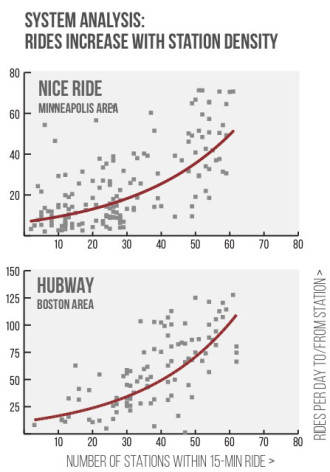
The 14 stations in the U District perform terribly, and their low use brings down the stats for the rest of the system. As a national study released after the launch of Pronto shows, the density of a connected network is vital to bike share success. Opening a bike share service area split into two is a doomed idea because then neither mini-network is big enough to make enough trips worth biking. Why pay for bike share when you can just walk?
But Puget Sound Bike Share won a grant specifically for U District stations, so they likely need to remain there to comply (though it is worth researching the options to help bolster the central system area).
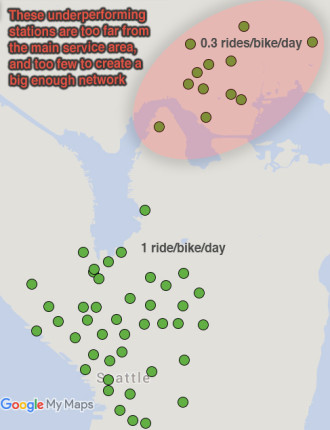 U District stations saw 0.3 rides per bike per day averaged across the first year of operations, which is very low. But Center City stations saw 1 ride per bike per day.*
U District stations saw 0.3 rides per bike per day averaged across the first year of operations, which is very low. But Center City stations saw 1 ride per bike per day.*
While better placement (and the March opening of U Link) can help U District stations work a bit better, the only way to make them truly succeed is to grow the system out and around the neighborhood. If at least Fremont, Wallingford, north Capitol Hill and the north University neighborhoods had stations, far more U District trips would be possible and convenient using Pronto.
But until the system expands north, the city needs to accept that these stations are going to underperform and plan accordingly.
Build the Center City Bike Network
Perhaps the most important way to bring Pronto to life is to unleash the delayed Center City Bike Network.
The most popular stations in the system today are in the Center City service area, but people must be willing to bike mixed with busy traffic in order to use them. And there are only so many people who are ever going to find that appealing.
But there’s a clear answer to this problem: Build the planned Center City Bike Network.
When the city opened the 2nd Ave protected bike lane in 2014, it was intended to be a demonstration project so SDOT staff could work out design kinks and people downtown could get used to the concept of a more modern and more comfortable bike lane. But the plan was to follow-up and connect the pilot bike lane to other bike routes to and through downtown. Yet it is now 2016, and there have been no new bike lanes downtown since.
This is a big problem for Pronto, because here is the disconnected bike network its users have to work with:
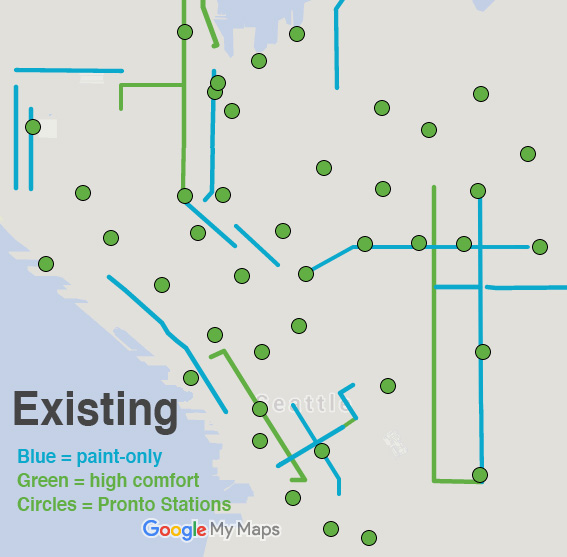
When you look at how disconnected the bike network is, it’s almost surprising the system gets as many rides as it does.
The good news is that the city has already put years of work into developing a Center City Bike Network, which would create a connected grid of bike facilities aimed at reaching people of all ages and abilities. In June, the city held a big open house that was extremely well-received and presented a series of options ready for implementation in 2016. The city’s short term bike plan from early last year also included the city’s planned 2016 bike lanes downtown.
Here’s what Pronto’s service area could look like if the Center City Bike Network’s 2016 projects went in this year as scheduled:
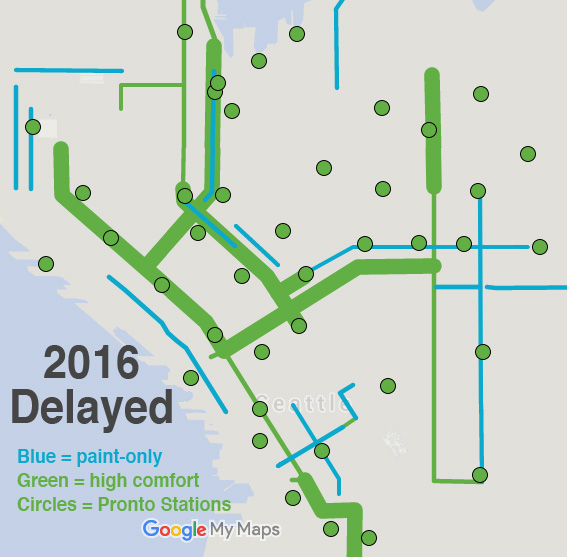 And here’s what that change looks like in GIF form (updated):
And here’s what that change looks like in GIF form (updated):
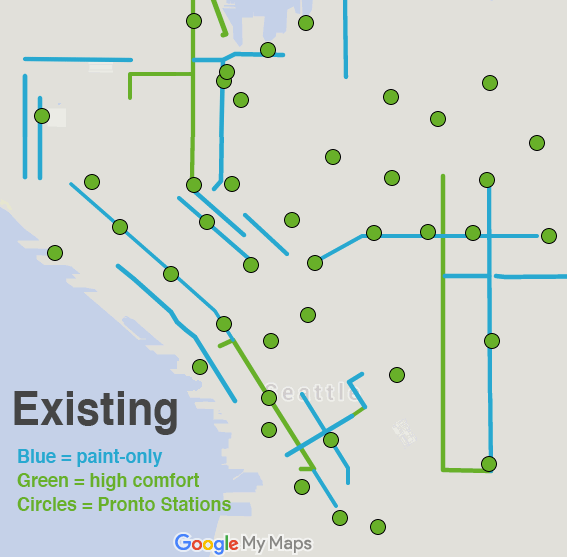 The Westlake Bikeway is under construction and due to open this year. According to a presentation to the Seattle Bicycle Advisory Board, the city also plans a protected bike lane connection from the new bikeway down 9th Ave and then on Bell and/or Blanchard to 2nd Ave. But that’s it. All other Center City Bike Network projects have been put on hold pending a step in the Center City Mobility Plan.
The Westlake Bikeway is under construction and due to open this year. According to a presentation to the Seattle Bicycle Advisory Board, the city also plans a protected bike lane connection from the new bikeway down 9th Ave and then on Bell and/or Blanchard to 2nd Ave. But that’s it. All other Center City Bike Network projects have been put on hold pending a step in the Center City Mobility Plan.
Wait, huh? Did I just say the Center City Bike Network Plan based on the Bicycle Master Plan is delayed because of yet another plan called the Center City Mobility Plan? Sadly, yes I did.
The Center City Mobility Plan is a $1.5 million plan basically to deal with how traffic and buses will flow years from now once the downtown transit tunnel becomes light rail only. That seems like a good thing to plan for, of course. But the city shouldn’t wait for it before conducting outreach and further design work for the bike lane network, especially the sections we know won’t be affected (like 7th Ave or extending the 2nd Ave bike lane north). This work can happen in parallel with the Center City Mobility Plan.
Seattle voted heavily for Move Seattle and the vision it represented. We have been planning the Center City Bike Network for years. There is no better time to act than right now in 2016. Let’s show the people what they voted for by finally, for the first time in generations, opening our downtown to low-stress bicycling. We may just save bike share while we’re at it.
Ditch the helmet law
We’ve written many times about how King County’s rare all-ages helmet law provides an unnecessary challenge to running a successful bike share system. Not only does the extra hassle limit spontaneous trips, but the addition of helmet vending boxes and the process for cleaning and refilling helmet bins is also costly on a daily maintenance level.
Many other cities, including Dallas just last year, repealed their all-ages helmet laws to help bike share succeed. It’s a well-intentioned law that has unintended consequences. Bike share is safe and good for public health. Let’s follow the success of other cities and remove the helmet requirement, at least for adults.
There’s a petition going around if you want to sign on.
*To get these estimates, I used James Wing’s Prontolyzer to see station trip data. I split the system into two: A 15-station, 150-bike system north of SLU and a 35-station, 350-bike Center City system. So U District/Eastlake saw 16,183 rides per 150 bikes while Center City saw 124,557 rides per 350 bikes. The numbers are a bit muddy because four stations came online during the year and do not have a full year of data. I excluded these stations and their trips in the calculations.








Comments
32 responses to “Bike share can flourish in Seattle”
Is there recent data now (e.g. from Dallas) that shows the impact of ditching a helmet law? What was the mode share change in Dallas before/after the bike helmet law was repealed?
Somehow I don’t see using physical activity in dallas texas as a useful benchmark for anything other than adult onset diabetes.
I doubt there’s enough data. The 2015 American Communities Survey isn’t out yet, but even that has such a big margin of error that it may be hard to see a change so quickly. I doubt thousands of new people rushed out to bike now that there’s no helmet law, and the bike share system hasn’t started yet: http://www.dallasnews.com/news/transportation/20151027-downtown-dallas-bike-sharing-plan-could-gain-traction.ece
For me, the helmet law thing is such a distraction in the conversation about biking. There are WAY bigger issues that affect bike safety, like infrastructure that prevents collisions from happening in the first place. We never should have passed it in the first place for this reason: It has always been a distraction, not a solution.
But now that we have it, it’s hard to build momentum for repeal. You’re fighting against something that seems like common sense, which is never easy. I would normally pick other battles over repealing the helmet law, but it really is hurting bike share. Go out and use Pronto for a short ride without a helmet. You’ll see how much easier the whole experience is. You’re upright and the bikes are slow with good lights and visibility. It feels reasonably safe.
I know it doesn’t seem that hard to put in a code, unwrap a helmet, adjust the size and put it on. But it’s significant enough to make a short trip not worth the work. And without the added cost, the books for Pronto would be that much closer to being balanced.
If Pronto can get more people active and getting their daily exercise, then that’s a big public health benefit.
Do the police use the helmet law as a pretext to pull over cyclists? That’s one of the reasons I’m quite opposed to a helmet law. It seems reasonable to assume that in most cities, were there helmet laws, the cops would harass the disenfranchised and downtrodden. I would guess–or at least hope–that Seattle doesn’t, but I do wonder if/how often the law gets misused.
Now that the UW Stadium Link station is opening, UW should sponser their own bike share system on campus to provide better transportation options for their students.. But they must put in many more stations on campus than they currently have to make it useful.
Helmet law, bike infrastructure, hills and rain are not anywhere nearly as big obstacles to successful bike share as people make them out to be. It’s the small number of bikes and stations plus poor siting that has caused the slow start to bike share in Seattle. Many stations are not visible from BRT/light rail stations/ferry/water taxi terminals/major intersections or popular destinations. People will figure out a way to use it if it is made useful. Siting of stations can only be really good if you have a lot of stations to work with in the first place and you can overcome siting and sponsorship challenges.
Pronto received a lot of input from users on their website about popular destinations for siting stations but for various reasons, Puget Sound Bike Share didn’t / couldn’t follow through. Before we diss them too much, they did face a lot of challenges given their budget and the size of the system they were able to launch. I, for one, would like to thank Holly Houser for making bike share at all possible in Seattle.
The UW should not reinvent the wheel, so to speak, but instead put more stations on campus, and integrate the payment system into ORCA, which the UW is part of already via the student pass. There is nothing wrong with hundreds of kids riding Pronto bikes around the campus, it’s not more “special” than people working downtown riding the bikes.
(And once they are used to this system, when they get jobs, interships etc, they’ll ride the same Pronto bikes downtown as well.)
Call me a socialist, but it’s like a library only of bicycles.
Support Pronto? Let the city council know right now by emailing city council! [email protected]
Thanks, Gordon, I was trying to find your group address for the council but I already did it the hard way.
Thank you for taking the time to write!
Pronto needs to be integrated into the ORCA/transit system. If you had a 1/2hr free ride with a bus ticket, it would be part of the transportation network.
It also needs a 4hr, tourist rental rate, not just this 1/2hr only, then check in system. People should be able to grab a bike near their hotel, and ride out to Myrtle Edwards park and the locks, and back without having to “dock in/out” it’s just nuts. You can argue that it’s designed for only short rides, but given how few bikes are actually ridden AT ALL, we can afford to have few out and about under a tourist.
People keep saying that about ORCA, but it ‘aint goanna happen, it looks to me as though if that were done it would make any employer subsidy of an ORCA card taxable income, see: https://en.wikipedia.org/wiki/Citi_Bike#Payment , the foot note links to; http://www.irs.gov/pub/irs-wd/13-0032.pdf
Even getting King county to change the helmet rule is just dreaming (not that it would be impossible for the city to have its own rules) but getting the IRS to change…
Besides which it wouldn’t be useful for most people anyway, while “the last mile” sounds good on paper, unless there is a station at each end of that mile it doesn’t do any good where the rubber hits the road. IF (lol) Pronto were big enough to actually be a meaningful part of the transportation system people wouldn’t blink at the annual rate. If one does buy an annual membership Pronto is so much cheaper (even if it were/ when it is as much Citibike’s $149) than Metro that it hardly seems worth the paperwork to try to combine the two, and the key fob can’t be that much of a problem to carry. Of course if Pronto disappears in three weeks, and annual membership wouldn’t be a good investment today, I say wait a couple years to see if it is stable first 3:-)
I don’t think 4 hour rate makes much sense either, while you are correct that currently nobody else wants to use the bike, if Pronto is to not remain a failure that would have to change. Also most bike shares are specifically intended to _not_ compete with private bike rental shops. In a few cases (where the PBS is part of government subsidized transportations system), non-residents are essentially prohibited from using the PBS, though many (most?) others do rely on _short_ tourist trips for a significant part of their income. At the current rates one can keep a bike for 2 hours for about $20, which may not be much more that a taxi ride to a bike shop for a “real” bike. Do you really want to ride a Pronto bike for 4 hours? Anyway, if a four hour rate was, say, $20, that would probably seem like too much up front so it wouldn’t get used. Sure I just said one can keep a bike for (only) 2 hours for $20, but if one decides they are not enjoying it, one can dock it within 1/2 hour and only be out $8. If the price is much less then system would be that much further away from its fantasy of being self supporting. And of course when (LOL) the system is big enough to be viable the 30 minute limit won’t be much of a problem.
“on mass transit facilities emphasis added) whether or not publicly owned. A bike share program is not a mass transit facility.
++++++++++
That seems like a ruling from a tax enforcement not a judge. So it’s subject to change. If we had enough bikes, then the sum total of that transportation could be considered “mass transit”, in addition it was “free” with the bus payment it would be part/partial of the trip.
In anycase, unless Pronto changes to a tourist friendly service, or becomes part of the transit system, I don’t see it doing very well.
I got stuck behind two big construction trucks on the trail near the aquarium. The flagger told me to watch out for one of the big trucks and I replied that it was a shame they were driving huge trucks on the path. He just pointed to the sea wall construction and said that’s why. So there is one more area where the city is making it difficult for bikes and pedestrians to feel safe. I pass two Pronto station there every day. It’s usually the easiest route out of the city except recently. It’s been an even bigger mess the last few months. Sad to know it won’t get better any time soon.
We need safer routes. Raised dedicated lanes like Copenhagen has would be ideal.
Reminds me of this morning when I’m going downhill in the rain on Dexter, the flagger just pops out of nowhere with a stop sign to allow a construction truck to reverse. It’s a gauntlet some mornings with those beastly trucks! I know it’s hard to decry economic development; I also know motorists are inconvenienced, but unless there’s a way I haven’t found yet it is by far the best and one of the only safe ways to take into town from Ballard. Dexter is, in essence, a major bike thoroughfare. I just wish it were seen by others as such. Those flaggers wouldn’t keep coming (which has happened six or seven times in three weeks) out when there was CLEARLY enough time–and always enough space– for me to safely pass.
“Seattle voted heavily for Move Seattle and the vision it represented.”
Unfortunately, there was not a very solid plan behind that vision so it is rather unreasonable to expect something coherent to be built in 12 months. Seattle does not work like that.
It is also totally ridiculous to be spending tens of millions on a city center bike network to make bike share a success. Put the bikes in storage and bring them out with new luggage racks or baskets when they are needed.
As for the U district, there will be a huge need to get UW employees from the new light rail station to all over campus, some of which is a mile away. What a great opportunity for bike share to at least get 10 rides per week per bike.
Excellent summary of the issues, Tom. Cancelling Pronto now would be so shortsighted.
I honestly think that Mr. Fucoloro should be put in charge of the Pronto system, when the City takes it over. He sounds like he has the right perspective and the right ideas for fixing it.
Ha! No thank you. I prefer to armchair quarterback on the Internet :-)
I don’t know what your real life gig is, but consider a stint in public service to get Pronto out of the mud and on track. Call it your “civic duty”.
There’s an active petition to repeal the helmet law, if you’re interested:
https://www.change.org/p/seattle-king-county-public-health-board-legalize-riding-a-bike-in-seattle-king-county
Excellent points as always Tom. I must once again submit a minority opinion to the blog that I don’t find it rational that the helmet law is a large impediment to people riding bikes. There are many safety laws such as the requirement to wear a seat belt or not using your phone while driving that I think should be more viewed as setting a social expectation than at stinging infringement. To be honest I cannot recall SPD issuing a single traffic ticket to anyone – driver or bike in my 12 years in Seattle. I am sure that it has happened and I am sure there is some example of injustice out there, but I don’t think it’s a systemic problem in need of a sweeping solution.
If people do not want the helmets they will not use them but they should be available and I think there is value in setting the baseline as “you should wear a helmet” similar to “you should wear a seat belt” and “you should not talk on the phone.”
Head injuries from accidents are serious, traumatic life altering events and we should do everything we can to stop them.
Seat belts, no phones driving, clean needle exchange, anonymous STI testing, food safety reglations and helmet laws are all there to reduce the burden of disease and morbidity in our community – partly by enforcement but perhaps even more importantly by creating a social-cultural barrier to needlessly elevated risk.
>> Head injuries from accidents are serious, traumatic life altering events and we should do everything we can to stop them.
Yes, like encouraging a bike sharing system, with or without a helmet law. Yes, I’m implying that a successful bike sharing system can reduce head injuries more than a helmet law will, and the data supports this: http://www.citylab.com/commute/2014/06/head-injuries-didnt-rise-in-bike-share-cities-they-actually-fell/372811/
There is no mutual exclusion here.
For any business, you need sufficient capital. You can’t open a taco truck unless you can afford the truck. Opening a factory takes a lot more money. What is true of a private business is true of a public agency. There is no point in building a light rail line with only one stop.
To have a successful ride share system you need a lot more stations. You need them in the areas currently “covered”, and you need to cover more areas. The UW is a losing proposition right now because there isn’t sufficient station density, nor sufficient area. There is only one station between Children’s and the UW. That is ridiculous. Likewise the coverage on the UW is just not very good. The northeast part of campus is completely ignored. There are just very few trips with the current set of stations that make sense for a bike.
But the UW is not unique in that regard. Most of First Hill and Capitol Hill remain without coverage. This is one of those areas where I could easily see myself taking Pronto. There are nice plateaus there, and plenty of destinations. But there just aren’t enough stations. There are only three stations south of Pine, and one is way down at Yesler. There are big expansion plans, but you better fill in the gaps or this will fail. People won’t walk three blocks, ride the bike, then walk a couple more blocks. It just doesn’t work like that.
The first bike share system in the country was in DC. It failed because there weren’t enough stations. The new DC system has more — a lot more. We need to either give up or allocate enough money for stations.
The operator agreed to absorb losses if we expand to 100 stations, and that’s written into the budget last I checked. That’s not big enough in the long run, but it’s a realistic tipping point for paying its own operating costs. Even 50 is ok once debt and overhead from the nonprofit are eliminated in March, but that leaves no leeway. There’s absolutely no need to give up now. Bigger is of course better, but 100 docks is big enough for now.
As far as funding goes, the money we are talking about isn’t huge, but it can’t be found under the cushions either. I know this can be kept alive for a lot less, but to really be successful I think you should spend around ten million dollars. That should get you enough stations to cover the current areas fairly well, and extend a bit. Go east to at least MLK, and south to at least Mount Baker. Go to the northwest, extending to Fremont. Again, the key is to add more stations in the areas where coverage supposedly exists now. Between I-90 and 520 there should be around a 100 new stations. Between I-5 and Children’s (north of the ship canal) there should be around 50. That would still not be as many as they recommend (28 per square mile) but that would be enough to really work. Otherwise I doubt you will have much success no matter how wide the coverage area.
Since bike share was not mentioned in in Proposition One, it is unethical and unrealistic to expect to spend money on this. But Proposition One did not allocate money for a streetcar, either (for political reasons). The city still wants to spend money on a streetcar, but before it does, it should spend money on this. It is possible that we will get grant money for previous projects, and the money should be spent for bike share first.
Pronto has not been very successful, but compared to our streetcar, it is holding its own. The streetcar carries 2,200 per day. It cost over $50 million. That works out to about $22,000 per daily rider.
The current Pronto system cost about $2.5 million, and is used by 400 people a day. This is a cost of $6,250 per daily user. Pronto — even at its stunted, immature state — is a much better value than the streetcar. The streetcar per user costs is over three times that of Pronto. If you expand Pronto, it is obvious it will be a much more popular, and thus much more cost efficient. We should expand Pronto and get it up to the appropriate level of service before there is talk of spending money on more streetcars.
[…] Bikeshare works: Tom Fucoloro says that bikeshare can thrive in Seattle. […]
[…] In a post last week, Fucoloro identified a few changes, in addition to scrapping the helmet law, that would help get Pronto back on track: […]
[…] As we wrote last week, bike share absolutely can flourish in Seattle. There were human-made mistakes in the launch (the U District satellite is too small and too far from the core, leading to dismal ridership there) and in management (the transfer from the non-profit Puget Sound Bike Share to the city was botched) that are holding it back. […]
[…] reported about how Pronto ended up in this do-or-die situation in front of the Council and how the system can flourish in our […]
[…] As we have reported, the U District stations are under-performing compared to the centralized mass of stations. Usability of a bike share station is dependent on the number of other stations within an easy bike ride, and there simply aren’t enough stations within a convenient bike ride of the U District stations. The new 45-minute free ride time brings more of the central stations within range, though they will likely still under-perform until the network expands. […]